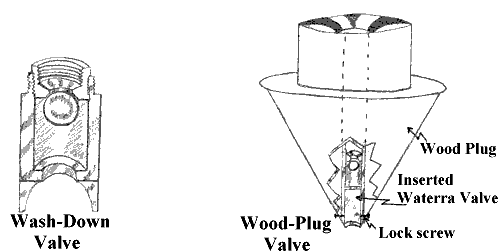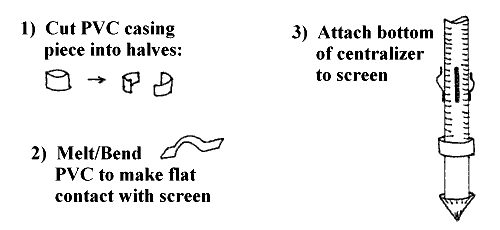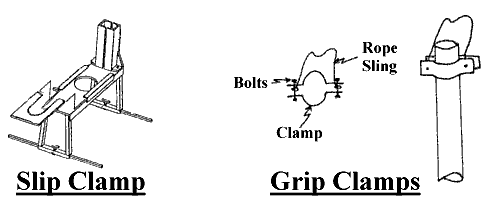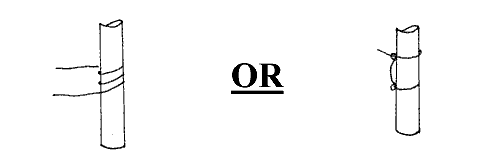
Section 7
Well Casing and ScreenTo keep loose sand and gravel from collapsing into the borehole, it is necessary to use well casing and screen. The screen supports the borehole walls while allowing water to enter the well; unslotted casing is placed above the screen to keep the rest of the borehole open and serve as a housing for pumping equipment. Since the well screen is the most important single factor affecting the efficiency of a well, it is sometimes called the "heart of the well"!
7.1 Screen Design
7.2 Screening Wells Drilled Into Rock
7.3 Screen Centralizers
7.4 Casing and Screen Installation
7.5 Solvent Welding (Gluing PVC)
7.6 Footnotes & references
Well screens should have as large a percentage of non-clogging slots as possible, be resistant to corrosion, have sufficient strength to resist collapse, be easily developed and prevent sand pumping (Driscoll, 1986). These characteristics are best met in commercial continuous-slot (wire wrap) screens consisting of a triangular-shaped wire wrapped around an array of rods (see Footnote #1). If these screens are available, conduct a sieve analysis on samples on the water-bearing formation and select a slot size which will retain 40-60 percent of the material.
While wire wrap screen should be used whenever possible, it may be exorbitantly expensive and/or not available. Most Lifewater wells are constructed using PVC casing and screen (Footnote #2) - see (Figure 9). Grey PVC pipe, which is available in most countries, is relatively cheap, corrosion resistant, lightweight, easy to work with and chemically inert.
Slot Design: Using a hack saw, cut slots in the plastic casing which are as long and close together as possible. Slots should be spaced as close together as possible vertically and should extend about 1/5th the circumference of the pipe; there should be 3 even rows of slots extending up the pipe separated by 3 narrower rows of solid, uncut pipe (for strength).
Figure 9: PVC Cut-Slotted Screen

Screen/Casing Diameter: Three inch diameter casing and screen can be easy inserted into the 15 cm (6 in) LS-100 borehole and allows creation of an effective 3 cm (1.25 in) thick filter pack (this is especially important where the aquifer is composed of very fine materials). However, since 7.6 cm (3 in) screen is often not available and has low total open area, carefully centered and filter packed 10 cm (4 in) screen is most frequently used. Larger diameter screens make the filter pack ineffective and do NOT significantly increase well yield. For example, moving from a 10 - 12.7 cm (4 - 5 in) screen will increase yield by 3 percent or less! Besides, a good filter pack expands the effective radius of the well to the full 15 cm (6 in) diameter of the borehole.
| Screen Length: For confined aquifers, 80-90 percent of the thickness of the water-bearing zone should be screened (Driscoll, 1986). Best results are obtained by centring the screen section in the aquifer. For unconfined aquifers, maximum specific capacity is obtained by using the longest screen possible but more available drawdown results from using the shortest screen possible! These factors are optimized by screening the bottom 30-50 percent of the aquifer (Driscoll, 1986). One 7m (20ft) length of screen is often adequate. Screening 6-7 meters beneath the water table generally assures adequate year-round yield (Brush, 198?). In many tropical areas, successful wells can be constructed by drilling 5 feet into underlying rock and placing a 10 foot screen which straddles the bedrock/overburden interface (see Appendix C-4) |
Bottom Casing: Significant quantities of fine materials are often present in the extreme upper and lower parts of an aquifer. Therefore, unless the aquifer is less than 7 m thick, extend the casing at least 1-2 m into the top of the aquifer before starting the screen. Similarly, unless the aquifer is very thin, ensure that at least the bottom 1-2 meters of the aquifer is completed with a piece of solid casing pipe. This casing (known as a "sump" or "rat hole") provides a place for solids to settle as they are drawn into the well, thus minimizing screen blockage and minimizing the amount of fines drawn into the well (see Figure 9 and Section 9 - Figure 15).
Bottom Plug: A plug ("drive shoe") should always be installed to help the casing slip down the borehole and prevent unfiltered fines from entering the well. A cap or pointed wooden plug are the most common plugs. If "belled" casing (with a built-in socket on one end) is used, the non-belled end can be shaped into a point. Finally, a wash-down valve can be used or a one-way valve (allowing water to flow out of the casing) can be installed in a wooden plug which has a beveled inner surface (Figure 10). This valve allows the well to be effectively rinsed-out and ensures that the filter pack is effectively placed.
If any type of wooden plug is used, it is good practice to place a cement plug at the bottom of the well to ensure that sediment can not enter the well when the plug rots out. Put thick cement in thin plastic bags, drop them to the bottom of the well and then smash them open using drill pipe.
Figure 10: Wash-down Bottom Plugs

7.2 Screening Wells Drilled Into Rock
No casing or screen is generally required in the portion of boreholes drilled into rock. The first 2 - 3 m of the rock borehole should be 15 cm (6 in) in diameter; the borehole can then be extended using a 10 cm (4 in) bit (this maximizes the drilling speed which can be very slow in rock). The 11.4 cm (4.5 in) OD casing should be placed into the 15 cm (6 in) hole and carefully aligned with the (10 cm (4 in) hole. Fill the rock annular space with 40 cm coarse gravel followed by 60 cm coarse sand/fine gravel with 100 cm medium sand on top (this prevents fine sands and silts often found at the overburden-bedrock contact from moving into the well). Since the main water-bearing zone may be within the upper few inches of bedrock, only seal the casing into rock with cement where contamination is major concern.
| 7.3 Centralizers: Whenever possible, centralizers should be used on the outside of the rising main ("drop pipe") and on the pump rods. Adding centralizers minimizes the chance of pump rods banging against the rising main during operation of the handpump. This can be a serious problem in wells over 12.19 m (40 ft) deep since it eventually leads to early wearing-out of the rods and/or holes being rubbed in the rising main... leading to pump failure! Centralizers are also very important when installing casing since slots in the well screen may become severely blocked with clay if the screen rubs hard against the borehole wall while it is being inserted into the borehole. Centralizers also ensure that there is even distribution of cement grout and filter pack. This is really important since if the screen is placed against the borehole wall, the well may always produce turbid water! Poor grout placement can result in contaminated surface water entering the well and making the water unsafe to drink! |
These problems can be avoided by attaching (gluing, screwing, tying-on with wire) 3 centralizer strips to the top and bottom ends of the screen. Centralizers can be made from PVC casing, flexible green wood or 1.2 cm (0.5 in) wide iron straps (see Figure 11). Only fasten the lower end of each centralizer (so that it can "flex") and do not put any on the casing or the screen/casing may jamb during placement. Centralizers work best with 7.6 cm (3 in) casing; jamming may occur when installing 10 cm (4 in) casing in the 15 cm (6 in) borehole (the outside diameter of schedule 40 PVC pipe is 11.4 cm (4.5 in) and the diameter of couplings is 13.2 cm (5.2 in)! If this is a concern, just make the bottom plug the same diameter as the couplings.
Figure 11: Casing Centralizers

7.4 Casing and Screen Installation
Make sure you know the distance from the ground level to the bottom of the borehole and ensure that the required lengths of well casing and screen are prepared, clean, close at hand and ready to install when the drilling is completed. Attach the casing sump with the drive shoe to the bottom of well screen. For more information on solvent welding, see section 7.5. If bell and spigot pipe is not used, pre-glue a joining coupler (collar) to one end of each length of casing (see Figure 12).
Figure 12: Preparing Pipe for Installation

Once the borehole is completed to the desired depth, continue to circulate drilling fluid through the drill pipe at the bottom of the borehole until the returning fluids are clear of cuttings, sand, and clay balls. The fluid in the mud pits may need to be replaced several times before the water exiting the borehole is clean. When it is, keep the fluid circulating and the bit rotating and slowly remove the drill pipe from the borehole.
When the drill pipe is removed, swing the engine/drive assembly to the side. Prepare to clamp the casing using 2 grip clamps formed from iron or wood: 1 clamp should be on the casing suspended in the hole and the other on the length of casing to be joined (Figure 13). Alternatively, use a casing slip clamp made from 1/2 or 3/8 inch steel plate by cutting a slot slightly larger than the casing and welding on a handle (Figure 13).

Keeping the borehole full of water, carefully lower the screen assembly into the borehole. Ensure that a grip clamp is attached or use a slip clamp to catch the casing should it slip while being lowered. One at a time, wipe clean, add and glue 6 metre (full 20 foot) lengths of casing (see Section 7.5). If a slip clamp is used, wrap a 1 cm thick hemp rope 3-4 times around the upper length of casing (Figure 14) and keep it tight when pulling the clamp back to ensure that the casing can not slip. After the slip clamp is back in place, lessen the tension on the rope and allow the casing to slowly slip into the well until it is again resting on the clamp. Continue to add and lower casing until the well screen reaches the bottom of the borehole. Then raise it slightly and suspend it using grip clamps or by tying a rope to the drill table (this ensures that the casing is placed straight). Work quickly to minimize the chance that the borehole may start to collapse.
Figure 14: Rope Wrap Around Casing During Installation

Keep track of the length of screen and casing that is installed to ensure that the well has not partially caved-in (see Appendix G-2) and to ensure that the casing reaches the bottom of the borehole and is not stuck part way down the borehole (see Appendix G-10. Keeping the casing suspended 10 cm above the borehole bottom, cut the top off the casing so that only about 50 cm sticks-up above ground level (see Section 9 - Figure 15 and Section 14 - Figure 17).
After the casing is securely suspended, thoroughly flush the borehole again with clean water (this greatly reduces well development time (Section 10). If a one-way valve was installed at the bottom of the casing, run drill pipe down inside the casing until it is engaged in the top of the valve. If there is no valve, place a tight fitting surge block or securely wrapped rag on the end of the drill pipe. Then set the end of the drill pipe down to the bottom of the screen and pump clean water down the drill pipe so that it is forced out through the bottom section of screen. If these flushing processes are not possible, rinse-out the casing by connecting the mud pump outlet hose to the top of the casing by means of a well cap and appropriate fittings.
Finally, bail or pump out the casing. If it can be bailed practically dry, develop the full length of the screen several times (Section 10). Continue until no further improvement in yield is noticed. If there is not enough water (Section 10.3), remove the casing and abandon the well.
Solvent weld the pipe segments using the following procedure (NWWA, 1981):
- Clean the contact surfaces of the pipe end with a clean, dry cotton cloth or paper towel.
- Roughening contact surfaces with abrasive paper ("sandpaper") helps develop a better bond. Sand the pipe by holding the paper around the pipe and turning the pipe around and around. This is better than sanding up and down lengthwise along the pipe;
- Check the fit of the sections to be cemented. A good "dry fit" should show the spigot end entering the socket to about one-half to two-thirds of its depth. Incorrectly dimensioned pipe or sockets should not be used!
- Apply primer to the outside of the casing end and to the inside surfaces of the socket to prepare them for joining (the primer may require more time to soften the belled end casing sockets than is necessary to prepare the sockets of separate moulded couplings);
- Apply a thin, uniform coat of solvent cement to the interior surface of the socket and to the exterior spigot end of the casing (too much solvent could weaken the casing);
- Insert the spigot end of the casing section forcefully into the socket to the entire depth of the socket while both the inside socket surface and outside surface of the casing are completely coated with wet cement. Give the casing a half turn when pushing together;
- Hold the socket and casing sections together for at least 15 to 20 seconds or until an initial set takes place. Then wipe the excess cement from the socket. A properly cemented joint should show a bead of solvent cement around the entire circumference of the casing/socket joint;
- To insure a strong bond, a joint should be allowed to set for at least 5 minutes. If less time is desired, drive three or four 95 mm (3/8 in) self-taping screws through each joint to ensure that the pipe can not separate during installation. Fully penetrating screws should not be used because their corrosion over time may leave a hole in the casing through which contaminants or bacteria may enter the well (Driscoll, 1986).
1 They are strong, allow maximum flow rates and the small slot size screens-out fines. In addition, the screen is unlikely to plug-up over time since sand grains cannot plug slots which are V-shaped and widen inward and sand particles can only make contact at two points (Driscoll, 1986). Finally, the closely pitched, continuous slot facilitates uniform well development (Schreurs, 198?).
2 The disadvantages of using a locally manufactured screen when compared with commercial continuous wrap wire screens are:
- since strength cannot be maintained if openings are closely spaced, the percentage of open area is lower (4-12% open area compared to 30-50% for wire wrap screens) thus restricting the entry of water into the well;
- the size of the slots varies significantly and slots cannot be made small enough to screen out fine sand;
- the screen tends to clog during the development process if the aquifer is composed of fine sand. Sand grains can lodge solidly in a round or square opening and greatly limit the effectiveness of the screen (Schreurs, 198?); and
- The blank areas between slots prevents all portions of the aquifer around the screen to be effectively developed.
Brush, R. (197?) "Wells Construction: Hand Dug and Hand Drilled", US Peace Corps, Washington DC.
Driscoll, F. (1986) Groundwater and Wells, St. Paul: Johnson Division
National Water Well Association and Plastics Pipe Institute (1981) Manual on the Selection and Installation of Thermoplastic Water Well Casing, Worthington, OH, 64pp.